When approached by Greenlee to test a new product late last year, we knew it was the perfect opportunity to work with a couple of our favorite electrical contractors, Adam Sperry and Jon Block. Jon and Adam have been friends of The Hub for several years and bring a ton of electrical experience and knowledge Read more
Featured

When approached by Greenlee to test a new product late last year, we knew it was the perfect opportunity to work with a couple of our favorite electrical contractors, Adam Sperry and Jon Block.
Jon and Adam have been friends of The Hub for several years and bring a ton of electrical experience and knowledge to our sites. We connected them with Greenlee and after a few projects over a couple months, they share their experience with the Greenlee GSB Series Step Bits.
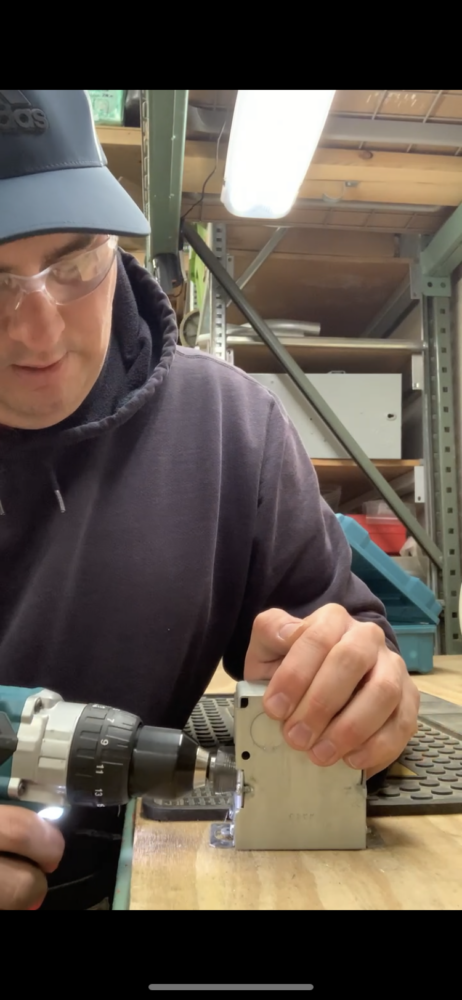
Jon Block reviews Greenlee GSB Series Step Bits
First off, the step bits are ideal for advanced hole making solution and feature an improved split-point tip for even faster penetration and a patented split-step design to optimize chip load for a faster and smooth cutting experience while achieving more holes per charge.
“These are perfect for making holes in conduit and steel junction boxes as well as enclosures for conduit knockouts or enlarging holes to accommodate larger conduit openings,” said Jon Block, LH Block Electric.
“There’s no reservations in using these bits, Greenlee has a long history in the trade of high-quality products. I’m sure Jon and I both look for a product that is priced appropriate to the results attained and Greenlee is a brand I trust and believe in due to their quality products,” Sperry shared.

Both agreed that the progressive cutting edges on the bits provided balanced aggression to maximize torque efficiency and minimize stalling when using a cordless drill.
Additionally, an improved double flute design provides enhanced chip evacuation, while also increasing cutting speed and bit life. Laser markings on the bits allow for easy part and size identification.
The GSB Series Step Bits for mild steel are offered in two sets, available in 10 Imperial-sized step bits ranging from 1/8-inch to 1-3/8-inch, and three Metric-sized step bits ranging from 4mm to 32.5mm.

Adam’s Final Assessment:
- “These bits are the fastest, smoothest, most durable bits I have used and have performed beyond expectations even when subjected to less-than-ideal conditions.”
- “Personally, I see step bits as a “consumable” item, which I feel is contrary to popular opinion. Most people feel as though the price associated with quality step bits somehow means they should last forever. I disagree. There are a lot of situations where the drilling is less than ideal, or the driller is less than adequately trained which can lead to more wear and tear on a bit. I also prefer the bits to NOT have the quick connect shaft or be impact rated.”
https://www.instagram.com/p/CI1l-qLDl5-/
Jon’s Final Assessment:
- ” I love the double flute design and the marked with common conduit knockout sizes and long-life durability.”
- “The split step and the longer step for the common conduit hole sizes makes this a great tool for quick knockouts instead of grabbing a hydraulic knockout set. Greenlee tools are the best in the electrical contracting business.”
- Facebook Product Video
Professionals interested in the GSB Step Bits can visit Greenlee.com/StepBits to learn more information. To request a hands-on tool demonstration from a Greenlee Pro Tool Specialist, visit Greenlee.com/requestdemonstration. For more information on Greenlee, visit Greenlee.com.
ProStaff Reviewers:
 Adam got his start in the electrical industry 20+ years ago from his father who was an electrical distributor general manager. Adam has always been keen on working with his hands and takes an extreme satisfaction in watching a project come together from start to finish. One of the keys he brings to our ProStaff is his ability to share whatever tools, insights, tips, tricks, and lessons that have helped him in his career. You can find him on social media at:
Adam got his start in the electrical industry 20+ years ago from his father who was an electrical distributor general manager. Adam has always been keen on working with his hands and takes an extreme satisfaction in watching a project come together from start to finish. One of the keys he brings to our ProStaff is his ability to share whatever tools, insights, tips, tricks, and lessons that have helped him in his career. You can find him on social media at:
- Instagram – completelycordless
- YouTube – Completelycordless
 Jon, after serving his apprenticeship and acquiring his Chicago Supervising Electrician License, Jon joined his family at LH Block Electric in 1998. Jon brings a unique and extreme work ethic and his many new innovative ideas to the company and currently serves as the job superintendent and chief estimator. He is also a certified electrical inspector and loves teaching the trade in the classroom and in the field. Jon can be found on Facebook at:
Jon, after serving his apprenticeship and acquiring his Chicago Supervising Electrician License, Jon joined his family at LH Block Electric in 1998. Jon brings a unique and extreme work ethic and his many new innovative ideas to the company and currently serves as the job superintendent and chief estimator. He is also a certified electrical inspector and loves teaching the trade in the classroom and in the field. Jon can be found on Facebook at:
- Facebook – LH Block Electric
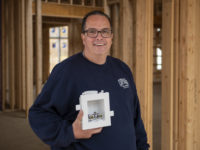
Mike Corsillo, a Ohio new-construction plumbing contractor, keys his success on rigorous planning, organization, and offering builders and consumers the “latest and greatest” for their homes. MODA Supply Boxes have proven a perfect fit with those business values. Third-generation plumber Mike Corsillo has a background familiar to many professional plumbers: tagging along with his dad Read more
Mike Corsillo, a Ohio new-construction plumbing contractor, keys his success on rigorous planning, organization, and offering builders and consumers the “latest and greatest” for their homes. MODA Supply Boxes have proven a perfect fit with those business values.
Third-generation plumber Mike Corsillo has a background familiar to many professional plumbers: tagging along with his dad to jobsites as a kid, thinking what fun it was to be at work with him. These good memories cemented his career choice – joining his father and brother at Corsillo Plumbing & Sewer Cleaning. In 1998, he launched the New Construction Division (NCD) of the family business.
However, after many years as one company, Mike set out on his own in 2004. He established NCD Corsillo Plumbing in suburban Cleveland. The name, of course, pays homage to his family’s history and his own future in the plumbing business. In 2020, Corsillo’s company will install plumbing in well over 200 new homes — despite the pandemic — while also handling about 30 to 40 remodels. With 22 employees and 14 trucks, Corsillo’s trading area extends roughly 80 miles from the headquarters office in Chardon.
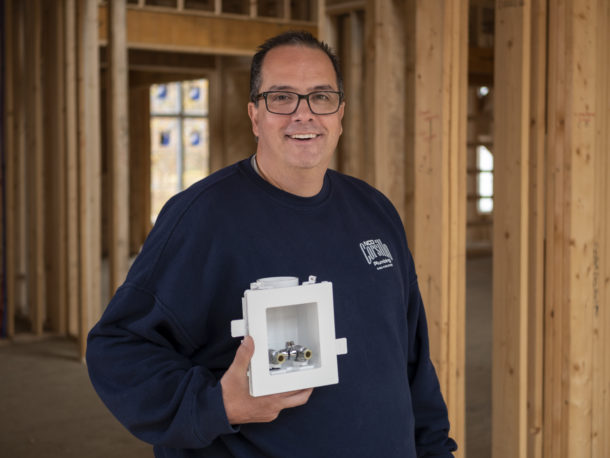
In the following interview with Corsillo, we explore what it takes for a plumber to successfully meet the needs of home-builder clients in the highly competitive new-construction market.
Question: Why new construction versus other types of plumbing work?
Mike Corsillo (MC):I really like the opportunity to engineer the jobs ourselves. Working in residential construction for 14 different builders, we do not receive a plumbing print. The builder will show us where the plumbing fixtures go, but how we get there — the size and layout of the piping — is done by us in the field. That part of the work always intrigued me, figuring stuff out.
Q: What are the keys to success in your type of plumbing work?
MC: Planning, organizing and scheduling. If you need to get to a particular destination, you don’t just get into your car and start driving. Likewise, before you go to pipe a home, you must have a plan. We are well-organized, making sure our crews have the materials and equipment they need when they need them, and that they are scheduled accordingly.
By “scheduling,” I don’t mean we meet every deadline; rather, we know how long it will take for us to complete a certain type of job. We forecast to our builders when we will finish. If a job is supposed to start on Monday, and I cannot get there, I can tell him our people will be there on Wednesday, and they know what we say is true.
I know my parameters, so I can be flexible in moving our schedule around.
Q: What slows you down on a job?
MC: We work with lots of variables: weather, other trades late to the job, delayed product orders, etc. We try to stay ahead of all that. For example, we schedule out two months, and order all our materials that far in advance.
We have also gone to iPads in the field so my guys have all their blueprints and other key documents on pads. Anything we get on paper, I digitize to consolidate information in one place — cabinet layouts, appliances, locations of the gas line and sanitary lines, etc. I mark up those digital documents, so everyone sees the same thing at the same time. This enables us to be much more consistent in our work. We always try to stay ahead, stay innovative, in an effort to save time and money, while improving our organization.
We made the digital leap five years ago, and it has made a big difference in our productivity and accuracy. The builders we work with, both national and local, share many of the same values about planning and organization. Instead of taking on builders at random, I try to match our organization with builders who believe in the same values we do, so they will actually listen to what I have to offer to help their companies.
At the end of the day, our company is just an extension of that home builder. His success is my success.
Q: What was your reaction to Oatey’s MODA Supply Box System when it was first introduced to you by Oatey rep Matt Decaprio of Preferred Sales?
MC: Initially I was a bit skeptical, but then Matt shared a case study on how the product delivered labor savings for the contractor on a big Nashville hotel. I read that story and there were a lot of similarities in how we calculate costs. So, I thought, “Maybe it would be a good fit for us, dollar-wise.”
As I do with any case study I read, I plugged in my own numbers and at the end of the day, I saw that the product saves time. But there were other considerations as well.
All those pieces and parts on a job can get lost or broken. The MODA Supply Box is a single unit that eliminates components and is a one-time installation, reducing the likelihood that something will get lost on the job site. It makes it very easy. We always looking for ways to streamline our materials, and this product aligned with that goal.
Q: How have your crews worked traditionally with this type of application?
MC: We used a bracket system, consisting of a metal bracket and a plastic 90-degree elbow that would receive our PEX into the bracket. At the rough-in stage, we would stub hot- and cold-water lines out of the wall in PEX, and then cap each line. Then we would test the line. During the finish stage, we would cut off the cap and then install a flange, a stop and a supply line to the sink.
The MODA Supply Box eliminates all those pieces except for the supply line. As a result, during the rough-in stage, we are doing not only the rough-in, but also part of the finish. It is all condensed into the single supply box, and there is no wasted material, which used to be the case when I had to cut off the cap.
Meanwhile, all those other components are no longer needed. All I need is the supply line that connects the faucet to the valve inside the box, which also contains a flange.
Q: Have you found other benefits with the MODA Supply Box?
MC: I’m a bigger guy, and it used to be a lot of “fun” squeezing myself inside some of these cabinets and vanities. With MODA eliminating cutting and capping lines, a mechanic simply hooks the supply line to the box. The installation is quicker and easier, we save money, and we’re not beating up our guys, either. Any time I can make the job easier by reducing the wear-and-tear, it boosts productivity.
MODA also finishes much more nicely for the builder and the homeowner by providing a cleaner, more consistent look on a project.
Q: Are there any other features that you like, especially in comparison with the old methods?
MC: I was pleasantly surprised and very impressed with the heavy-duty construction of the box itself, as well as how easily the valve can be replaced if you do have a bad valve. It is a high-quality product, and I am impressed with it just as I am with all Oatey products.
Q: What kind of savings are you achieving in time and dollars?
MC: We save approximately 15 to 20 minutes on each unit, while we pay only $5 more for the MODA Box than what we paid for all those now-unnecessary components combined. So, we are seeing a savings of approximately $20 per supply box, including both the rough-in and the finish.
Each home we do uses eight to 24 boxes — the latter figure for some of the larger, custom homes we currently do. Eight is the average. We buy in bulk, again to save money, and they come in a crate of 12, and our guys are bringing back three to four boxes from each crate.
That might not seem a huge amount of money, $20 per box, but let me tell you it certainly is. In today’s market, prices area always rising, but it’s not like I can run to the builder for a concession to cover all those increases. As a result, any savings we can achieve is a total bonus, helping us to offset the constant fluctuation in commodity prices. Eight MODA boxes per house times $20 per box equals a savings of $160 per home. In a neighborhood of 200 homes, that adds up to a very nice savings.
Q: The MODA Supply Box seems a pretty good fit with the way you plumb homes.
MC: To date, we have done 15 homes with the product, and we plan to continue using it. We always want to separate ourselves from the competition at least a little. And we want the customer to know they are getting the latest and greatest products in their new home. Just like cell phones: No matter what you have, the new one always seems better. We are trying to do that with plumbing products.
When we see a product that can help us promote a new home, make it different in the eyes of the buyer than the guy’s home next door, it’s a win for us and the builder.
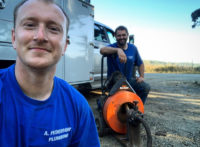
A lot changes in a decade, but for A. Pederson’s Plumbing in Dallas, Oregon, you wouldn’t know it by looking at one of the Maxi-Rooters from General Pipe Cleaners coming off the company’s trailer. Pederson’s two Maxi-Rooters have been the company’s go-to machines for more than 10 years, and with the exception of the feed Read more
A lot changes in a decade, but for A. Pederson’s Plumbing in Dallas, Oregon, you wouldn’t know it by looking at one of the Maxi-Rooters from General Pipe Cleaners coming off the company’s trailer. Pederson’s two Maxi-Rooters have been the company’s go-to machines for more than 10 years, and with the exception of the feed bearings, they retain all their original components, including the original Flexicore® cable.
“When you look at what else is out there on the market, there’s nothing quite built like the Maxi-Rooter,” says Trenton Hargrove, plumber at A. Pederson’s Plumbing. “While other companies’ machines are predominantly plastic, the Maxi-Rooter is built like a tank. It’s a really beefy machine you can throw around and don’t have to worry about it breaking down.”
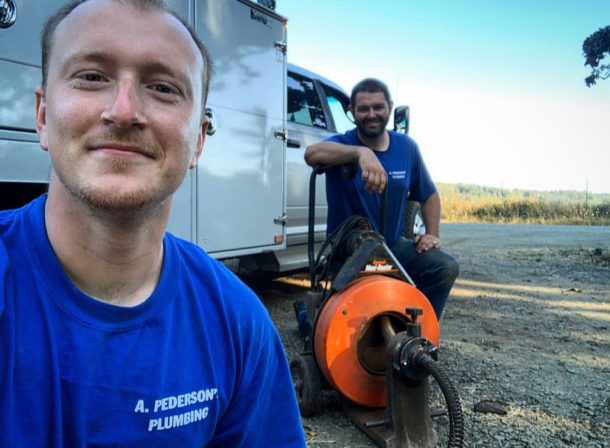
Family owned and operated since 1973, Pederson’s provides a wide range of plumbing services to Oregon’s Willamette Valley region. In recent years, the company has taken on more jobs in the commercial and industrial sectors. One such job that comes to mind for Hargrove involves a new construction site, an uncooperative line and a can of glue.
“A site had 3″ lines that were clogging up, which is uncommon for new construction,” Hargrove recalls. “A company that specializes in drain cleaning wasn’t able to figure out the problem, so we pulled the toilet and put a camera down the line. We found out someone dropped an ABS glue can down the line that glued itself to the pipe. We sent our Maxi-Rooter and ripped it right out!”
Built for portability as well as power and capacity, the USA made Maxi-Rooter rolls on 10″ ball bearing semi-pneumatic wheels and has V-belt stair climbers for easier transport up and down stairs. The machine clears roots and heavy stoppages in 3″ to 10″ lines and holds 125 feet of 3/4″ and 150 feet of 5/8″ Flexicore cable.
General’s heavy-duty Flexicore cable has a wire rope core tightly wound inside. It offers superior kinking resistance and unequalled strength with the right amount of flexibility. It’s so tough that it carries the best warranty in the business. Take a look for yourself and see it in action!
For cutting tough tree roots, Hargrove and his team use a 24″ leader at the end of the snake on the Maxi-Rooter. The flexible leader helps get around tight bends and traps and takes most of the abuse on a job, which helps preserve the integrity of the machine’s snake. Hargrove remembers one particularly daunting root job in which a giant oak tree outside a house had caused a significant line break in a 3″ pipe.
“These roots kind of make their way in there and we were probably 35 to 40 feet down the line the line,” Hargrove remembers. “With the Maxi-Rooter, we were able to clear it in 45 minutes with no problem. That’s why it’s our go-to machine!”
Pederson’s loyalty to General products goes back more than 20 years. Along with its trusty Maxi-Rooters, the company carries General’s JM-3080 gas powered water jetter and several Super-Vee small line drain cleaners in its arsenal. However, the Maxi-Rooter is a company favorite. Beyond its low maintenance and heavy-duty construction, Hargrove says the Maxi-Rooter’s sheer performance makes the machine a worthwhile investment.
“In addition to the power and mobility, we are able to clean these lines out faster, which saves our customers money,” Hargrove concludes. “We’re able to fit more jobs in our day, so we’re making more money. And when you don’t have to worry about downtime of fixing machines, it makes the Maxi-Rooter a very desirable piece of equipment to carry around.”

In July 2020, we ran a feature highlighting the release of Marcum LLP’s first annual Marcum National Construction Survey. Overall, the survey reflected a fairly positive outlook by respondents about the current and future state of the industry, despite the COVID-19 pandemic. The survey was conducted in the first quarter of 2020 by Marcum’s national Construction Read more
In July 2020, we ran a feature highlighting the release of Marcum LLP’s first annual Marcum National Construction Survey. Overall, the survey reflected a fairly positive outlook by respondents about the current and future state of the industry, despite the COVID-19 pandemic.

The survey was conducted in the first quarter of 2020 by Marcum’s national Construction Services group, a premier provider of accounting, tax, and advisory services to the construction industry.
According to Joseph Natarelli, Marcum’s national construction industry leader, said, “The industry was well-positioned prior to the pandemic, even with a potential recession looming. Those going into COVID-19 with weaker balance sheets will be negatively impacted. We believe that as long as firms work with their internal teams and professional advisors to address labor safety issues and material sourcing, and have a pandemic plan in place, they will come out of this in good shape.”
We recently conducted a Hub Chat with Mr. Natarelli to expand on the survey, industry trends, hot button topics as well as discuss his direction of Marcum LLP’s Construction Services Group, which is dedicated to assisting contractors with personalized and attentive service, strong technical expertise, and uncompromising integrity.
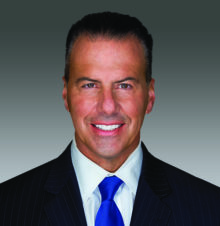 Mr. Natarelli is leader of the Firm’s national Construction Industry Practice group, as well as the Firm’s office managing partner in the Long Wharf Drive office in New Haven, Connecticut. In addition, he is a member of the Firm’s Management Committee. Natarelli has more than 30 years of experience with international accounting and consulting firms. He frequently serves as the lead audit engagement partner for a variety of consulting matters.
Mr. Natarelli is leader of the Firm’s national Construction Industry Practice group, as well as the Firm’s office managing partner in the Long Wharf Drive office in New Haven, Connecticut. In addition, he is a member of the Firm’s Management Committee. Natarelli has more than 30 years of experience with international accounting and consulting firms. He frequently serves as the lead audit engagement partner for a variety of consulting matters.
Mr. Natarelli frequently speaks on accounting and auditing matters. For more than two decades, he has served as a technical reviewer for the AICPA’s Audit Risk Alert for Real Estate and Construction Industry Developments and the AICPA Audit and Accounting Guide — Construction Contractors.
He has been interviewed by a number of prestigious media outlets including the Wall Street Journal, Bloomberg, Businessweek, Fox Business and now, Mechanical Hub Media.
The following is our Hub Chat with Mr. Natarelli.
MH: Thanks for taking some time to chat with us. What’s the Marcum LLP elevator speech and how does your team create construction curriculum for construction contractors and industry observers such as the National Construction Survey, which we shared with our readers last month?
JN: Marcum is a top national accounting and advisory firm that places a high value on being industry experts and resources for our clients and friends in the marketplace. We know contractors can get their basic financial reporting needs met at a lot of firms but what sets us apart is our commitment to excellence and leadership in their specific sector. This mission is further realized in a curriculum of in-depth thought leadership, instruction, benchmarking and more. For example, our nationally renowned Chief Construction Economist, Anirban Basu, provides hard data and analysis about and for the construction industry each quarter to our subscribers.
MH: Tell us a bit about yourself – how long have you been involved with Marcum, focused on Construction Services and what has your journey looked like up to this point in your career?
JN: For over 10 years, I have served as the Firm’s office managing partner in New Haven, Connecticut, and the leader of our National Construction Industry Practice group. I previously served as the national construction leader at UHY LLP before the UHY’s New England region merged with Marcum in 2010. I have over 30 years of experience with providing auditing and consulting services and remain a resource on various construction projects, offering expertise on job performance and enhancing profitability to contractors. I also spend my time providing thought leadership on accounting and auditing matters for various industry events and publications, and I have served for more than 10 years as a technical reviewer for the AICPA Audit and Accounting Guide – Construction Contractors and the AICPA’s Audit Risk Alert for Real Estate and Construction Industry Developments. I had the privilege of chairing the AICPA National Construction Program Conference Committee from 2012-2014. With one of the best teams in the industry, I have helped lead Marcum to become a top national accounting services leader for contractors.
MH: The COVID pandemic has created disruption and uncertainty across all segments of society, how is Marcum working to address issues that affect construction markets such as loan programs, taxing issues, and business interruptions?
JN: In a crisis, people need answers and they need them right away. Marcum established a Coronavirus Resource Center in mid-March and has been producing timely and essential thought leadership specific to the construction industry, ever since. Whether that takes the form of an alert, a tax flash or an in-depth webinar, our construction industry clients and other subscribers have access to the newest information available via the resource center. We have been leading the charge with our construction clients to make sure that they are taking full advantage of governmental programs that can support and preserve their businesses during this difficult time. At the end of the day, we know that our clients aren’t just companies, they are people who have worked to provide for their families and communities for years and we will do everything in our power to see that they make it through this intact.
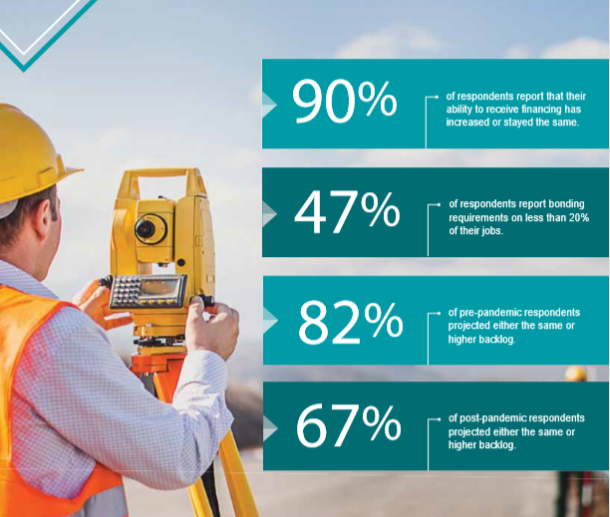
MH: As we started 2020 the construction market had seen significant growth over the past 5+ years, how is the current economic climate affecting the industry? What are some of the challenges and how is Marcum addressing those challenges? How can contractors use market data to set their business in a better direction?
JN: The crisis has really put a spotlight on challenges that have been haunting the corners of the industry for a while. Specifically, the labor shortage. In our quarterly Marcum Commercial Construction Index we’ve seen access to skilled labor bubble up to the top of the challenge list for the past few quarters. While unemployment is up in general, a lack of an organized trade educational system and other factors have put commercial contractors in a vice where there aren’t enough workers to execute all of the jobs they have and those that are available are being paid at a premium. Our annual JOLT survey is an essential tool for contractors to reference as it indexes wages across subsectors and positions and would be a valuable benchmark.
MH: Tariffs and trade policies are hot button topics as we get deeper into the election year. What are a few trends you’re seeing based around the election or how is the election affecting the market?
JN: The threat of trade war and an uncertain diplomatic future with China can have a bottom line impact on construction contractors, today. For example, tariffs on essential material such as steel or aluminum can cause hard cost price increases. The global pandemic has also choked off or threatened to choke off supply chain routes and sources – another area worthy of concern and, more importantly, innovative solution. Industry best practice should be to secure your key materials from a geographically diverse but still economical set of sources, lock in your pricing, and get those goods stateside and on the jobsite, ASAP.
MH: How is Marcum addressing environmental issues in the industry?
JN: The construction industry has been at the forefront of changing the way America interacts with its environment, since the beginning. Whether it is the use of innovative materials, high tech insulation techniques, green technologies, water recapture, or the reclamation of abandoned or “brown field” land for redevelopment, there is someone in a hardhat making it happen. Aside from the obvious social capital that helping the environment provides, there are credits and incentives from the government which construction contractors can take advantage of to align their environmental goals with their financial success. We work with numerous clients in that exact position and it can really make a difference.
MH: What are a few trends that Marcum has identified in the industry?
JN: There are several issues and trends Marcum has identified in the construction market. These include ESOPs, revenue recognition, cybersecurity, succession planning, burden analytics, SALT consulting, valuations, due diligence & quality of earnings, public private partnerships and Section 179D energy deductions. Additionally, we have identified 3 trending categories for construction: technology and innovation (i.e., project management software, building information modeling, drone usage, green design & construction technology, improved safety equipment), profitability (i.e., growing material costs, maximizing labor while decreasing labor force, targeting Gen Z in the work force, analytics and data) and sustainability (preservation of the environment, efficient use of resources).
MH: How do you see Marcum helping to create change in the future?
JN: Marcum, as a firm, has embraced technology in all parts. For our clients, we take the same approach. Whether it be through software consulting, robotic process automation, cloud computing or other new tech, we’re always looking to help our clients improve their processes and increase their profitability.
MH: What are some of the things you’re doing to boost Marcum’s visibility and grow market share?
JN: Marcum’s Construction Group is proud of their long history of membership and leadership with all of the major national and regional construction trade organizations. We just can’t overstate how important it is be shoulder-to-shoulder with your clients in the places where they play. To see and be seen. Of course, we hope that our commitment to the creation of business-critical content such as the Marcum Commercial Construction Index, the JOLT report, the national Marcum Construction Survey, our newsletter and flashes also helps keep us in front of decision-makers and position us for growth with them. We also host our own large-scale industry events in several regions, the Marcum Construction Summit. Our events are dedicated to updating construction contractors and finance and accounting professionals on the economic state of the construction industry. The Summit features high-profile, nationally recognized speakers who are experts in the construction arena.
MH: Crystal ball time, what’s 2021 and 2022 look like in the construction industry after all the turmoil of 2020?
JN: The long-term effects of COVID-19 are unknown, and the future of the construction industry is uncertain; however, we remain optimistic. Pre-COVID, 72% of economists were predicting a recession would occur by the end of 2021. As such we were encouraging firms susceptible to business cycles to take steps in building up cash reserves and strengthening relationships with bankers and insurers to prepare for 2022 and 2023. However, the pandemic affected the economy at a faster pace than expected and moved up the predicted timetable. With the country slowly reopening and with the hopes of a vaccine in early 2021, we are now more optimistic about the construction industry in late 2021 and 2022.
MH: In closing, is there anything you’d like to add?
JN: Stay the course, continue the blocking and tackling. We are going through a tough time but we are optimistic moving forward.

These are unprecedented times for us in the building trades. The COVID-19 crisis has brought on tough challenges, many changes and endless obstacles, but the industry is strong and resilient—right now we lean on each other. We are all in this together! And, as each day brings more and more coverage on the COVID-19, its Read more
These are unprecedented times for us in the building trades. The COVID-19 crisis has brought on tough challenges, many changes and endless obstacles, but the industry is strong and resilient—right now we lean on each other. We are all in this together!
And, as each day brings more and more coverage on the COVID-19, its impact on communities, and the economy, it’s also revealed some incredible stories we want to shine a light on. One such story is of Cherie & Jack Jester, owners of Benjamin Franklin Plumbing and Mister Sparky in Oak Hall, Virginia.
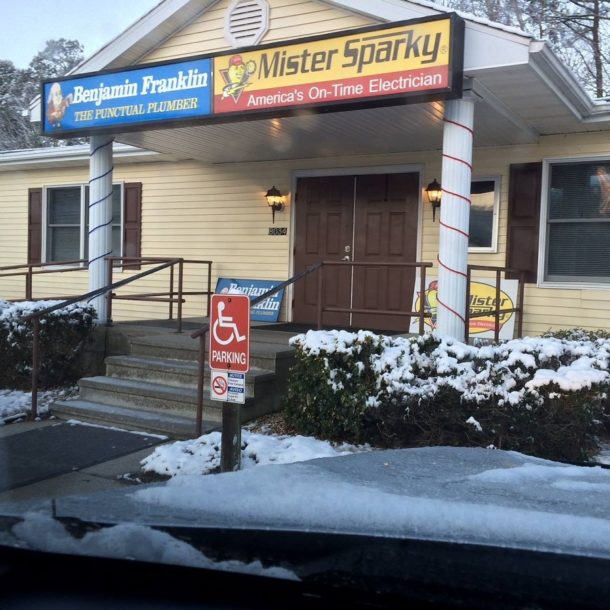
Cherie, Jack and their team of employees began helping their community through a program to assist people, especially those struggling from abuse, addiction and underserved in the community. The Jesters and their team of plumbers and electricians make deliveries twice a week to a neighborhood women’s shelter. Items being delivered include necessities such as toiletries, diapers, baby wipes, food, and various other supplies to give to those who are struggling. The company has had a relationship with this shelter for several years and have recently added a food and supply drop off location outside the office so the general public can stop by to make donations that will be delivered by their team. Working with a local radio station, they are also publicizing the program to drive awareness of the need in the community.
In addition to the great work Cherie and Jack are doing, they are looking for future programs to assist and hope to team up with other Mister Sparky and Benjamin Franklins in the region. They’ve been lucky during the past few months of COVID-19, as their team is staying busy and all the techs are working. Initially, Cherie and Jack could not find supplies for masks, but through their community outreach, found someone to create them for the whole team. They follow strict guidelines and protocols for social distancing and limit customer contact as much as possible.

I recently had a chance to ask Cherie about their business, philanthropy, and how the pandemic has changed the way they do business.
MH: Give us a little background on your team with Mister Sparky and Ben Franklin Plumbing?
Cherie: Jack and I started our company in 1989 as a new construction plumbing contractor. We decided to change our primary focus to service in the late 1990’s and joined the Benjamin Franklin Plumbing franchise in the fall of 2006, and we added Mister Sparky to our portfolio in 2008. Our son, Lee, has grown up in the business and serves currently as our Operations Manager. Our team of professionals at Benjamin Franklin Plumbing and Mister Sparky Electric can solve plumbing and electrical problems quickly and efficiently with our guaranteed on-time service, fully-stocked trucks and highly-skilled technicians. Some of our specialty services include bathroom remodeling, water testing and purification, home automation, house rewiring, among many others.
MH: How was the relationship created with the shelter?
Cherie: Our relationship with the local neighborhood women’s shelter began through our office manager, Leesa. Leesa had been incredibly involved for several years with a special Christmas project for the shelter families. She and a few other volunteers would take a “Christmas Wish List” of items (toys, clothing, coats) for every child and parent in the shelter and go shopping for them, wrap the gifts, and then deliver everything right before Christmas for the shelter staff to distribute. Our company and team members all contributed at first and our involvement continues to grow. Last year, we wanted to increase our giving, so we matched the contribution each team member gave. This encouraged more participation from our entire staff.
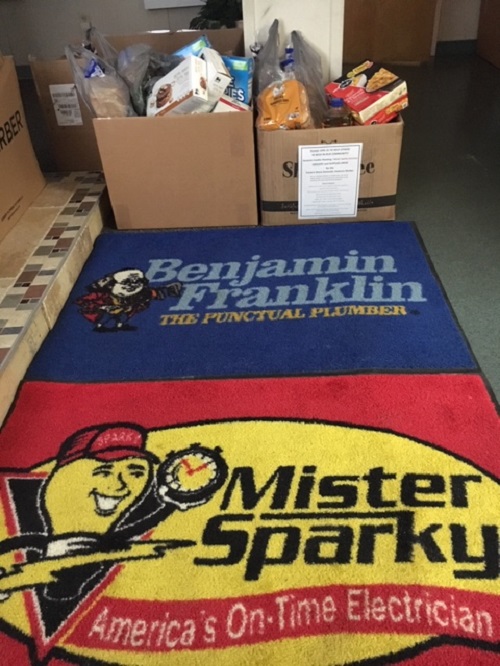
MH: How has COVID-19 changed the way you do business?
Cherie: We have been fortunate enough to be able to keep all of our team working in spite of the impact from COVID-19 on the economy, and we are very thankful. The health and safety of our customers and employees has been our biggest priority, which is why we implemented procedures based on information from the Center for Disease Control and Prevention (CDC). We require all of our employees to wear Personal Protective Equipment (PPE) including masks and gloves, as well as practice social distancing and regularly wash their hands and sanitize, and we’ve been making changes to reduce our in-person contact.
MH: What other programs or areas do you see as potential for supporting philanthropic endeavors?
Cherie: We love giving back to the community and are always looking for ways to help, especially since we have a strong support system from our employees who aspire to make a positive impact. We’d love to partner with nearby Mister Sparky and Benjamin Franklin Plumbing franchisees in the area to continue to build upon our giveback efforts. Beyond the women’s shelter we work with, we are long-time supporters of our local volunteer fire companies and we are reaching out to a local homeless shelter to see if we can help them in any way.

MH: Can you share any insight or personal stories about someone that has benefited from the support?
Cherie: When COVID-19 began to impact our community, we learned that there was an increase of families being taken into the shelter. Due to the increase there was a high demand for extra items, so we wanted to help. We decided to go shopping for them ourselves, collect items at our office from our team and anyone else wanting to help, and make deliveries to the shelter during the pandemic. Through these efforts we’ve donated several boxes of food, toilet paper, and various other supplies to give to people who are struggling.
MH: What do you hope others in the industry may take from reading about how you support in your community?
Cherie: We wanted to help our community in this time of need and are overwhelmed with the support we received from our employees, our local community in Virginia and our franchise family with Mister Sparky and Ben Franklin Plumbing. We hope our story will bring inspiration to others and motivate them to look for ways they can be a blessing wherever they are.
Having the team from Benjamin Franklin Plumbing is a gift for those in their community with little means or in need of a helping hand. As this pandemic continues with unknown speed, we can’t forget the most vulnerable who need even more support. So, if we are all in this together, we must include, plan for, and protect our most vulnerable too.
Cherie, Jack and the team of employees, Thanks You!
